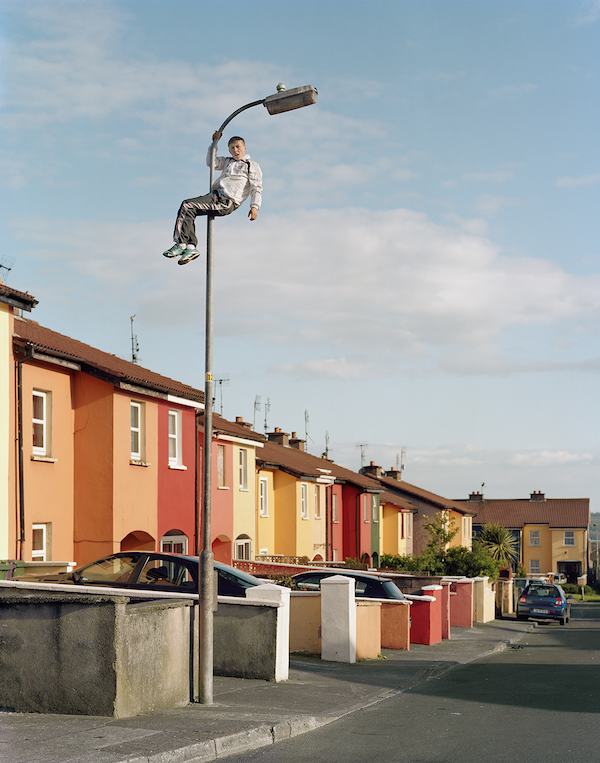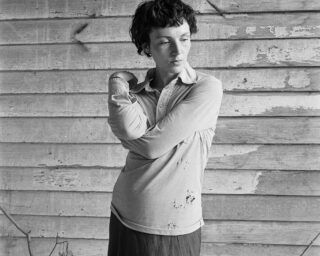Doug DuBois on Kickstarting My Last Day at Seventeen

Mary, Cobh, Ireland, 2011
This month Aperture launched a Kickstarter campaign to ensure the publication of My Last Day at Seventeen by Doug DuBois. When DuBois first went to Ireland, what began as a month-long residency grew into a five-year project about an exceptional group of young people from a few blocks of a housing estate in Russell Heights, in Cobh, Ireland. DuBois gained entry to the community when two of its residents took him to a local hangout spot, opening his eyes, “to a world of the not-quite adults, struggling—publicly and privately—through the last moments of their childhood.” Over the course of many summers, DuBois returned to Russell Heights to make portraits and capture spontaneous encounters and collaborative performances. If the related Kickstarter campaign is successful, in fall 2015, Aperture Foundation will publish My Last Day at Seventeen as well as a unique “community edition,” produced especially for the individuals featured in the book. Robyn Taylor, editorial consultant to the Aperture books program, spoke with DuBois about the project and how he plans to make the book a reality. This article first appeared in Issue 3 of the Aperture Photography App: click here to read more and download the app.
Robyn Taylor: For those of us who don’t know, can you give us a little background on how this project began?
Doug DuBois: I came to Ireland in 2009 at the invitation of the Sirius Arts Centre in Cobh. The director of the arts center, Peggy Sue Amison, connected me with a group of young people who were interested in photography and during the course of my stay we made a Blurb book together.
A few weeks into my residency, I asked the group of kids to take me to their neighborhoods and show me around. One couple, Kevin and Eirn, who were inseparable at the time, offered to take me to “the steps,” which, as it turned out, was a drinking spot frequented by underage kids that goes back generations. Later that night, I wound up at Kevin’s house in Russell Heights, a working-class housing estate only a short walk up the hill from the steps.
I went back to Russell Heights every day after that night. I was met with a mix of curiosity and disdain; occasionally the local Garda were called out to check my ID. Since Kevin and Eirn could vouch for me, I was never seriously considered a threat or a nuisance—but that first summer was a little rough. Years later, I asked Kevin’s sister, Roisin, what people thought of me that first summer—she laughed and said. “We all thought you were a perv.”

Lenny on the Steps, Cobh, Ireland, 2009
RT: How long did it take to build a level of trust that would allow you to return each summer? Have your intentions for the project always been clear to both you and your subjects, and at what point did you decide the work should be made into a book?
DD: Kevin and Eirn were born one day apart and at the end of that first summer in Cobh, I was invited to their eighteenth birthday party. The night before, I took some photographs of Eirn in her parent’s back garden wearing a new dress—a birthday present from her father. She said at one point, “It’s my last day at seventeen,” and I knew then I had a title for the project.
When I left the party, I told everyone I’d come back the next summer with the photographs. I doubt any one expected me to live up to that promise, but when I appeared the following year with stacks of prints, a tenuous sense of trust began to develop. When people asked me what the photographs were for, I always told them there would be an exhibition at the Sirius Arts Centre and, if I was lucky, maybe a book.

Jordan up the Pole, Russell Heights, Cobh, Ireland, 2010
RT: All the images in the My Last Day at Seventeen were taken during your summer residencies. Did you ever feel like you were missing pivotal moments in the community or the kids’ lives throughout the rest of the year? How did it feel returning each year?
DD: The book depicts an eternal summer—there’s no school and the weather is mostly sunny and warm. I never set out to document, in the traditional sense of that word, the life of the community. My idea was to contemplate the threshold that marks the time between childhood and the advent of adult responsibilities. While this somewhat lyrical framework involves, at least in part, creating a portrait of these kids and their community, the end result, like an eternal summer, makes use of the fictions and metaphors about youth and coming of age.
I was excited and anxious when I returned each year—nervous, I think, for the inevitable time when I would wear out my welcome. Some of the kids changed so much from one year to the next that I didn’t recognize them; and others, who were happy to be photographed the previous summer, made it clear they had had enough.

Padjoe in his Father’s Kitchen, Cobh, Ireland, 2011
RT: Instead of a traditional text, the book will contain a short comic by Dublin-based illustrator Patrick Lynch. Can you explain how this idea came about and what you think it adds to the project? What has been your experience of working with an illustrator?
DD: I originally wanted to commission a short story from an Irish author to accompany the photographs. After I complained about getting turned down by several writers, [Aperture publisher] Lesley Martin suggested a short, graphic novel instead. I did a little research and discovered Paddy Lynch, who runs a small press and writes and illustrates these wonderful stories of life in Dublin. Nothing much happens, which I liked, but they hold a world of detail and emotional nuance.
Paddy came up to Russell Heights with me last summer to record stories as people looked at the book maquette. He made sketches and I made photographs for him to take home to Dublin. We promised everyone involved that we would combine and change details so no one person is easily recognized through their story. There are only two, unnamed characters in the comic—simply, “the girl and the boy.”
My hope for the comic is, more or less, the same as for the short story: to create a narrative that runs parallel to the sequence of photographs. The trick is to avoid any direct, illustrative relationship that shuts down or limits meaning in and between the photographs and the comic.

Doug DuBois, Dean Shows his Tat, Russell Heights, Cobh, Ireland, 2009 © Doug DuBois
RT: In the Kickstarter video, you talk about the book as being a final stage in the exchange or “gesture” of giving something back to the community. Can you talk a bit more about the importance of this gesture and how readers can help to make it a reality?
DD: Every summer, we were routinely mobbed the first day we appeared in the neighborhood with boxes of prints. We’d see them later in the summer taped up on bedroom walls and occasionally blowing about the alleys.
In the fall of 2012, I had an exhibition of the work, as promised, at the Sirius Arts Centre. There wasn’t a framed photograph in the gallery that hadn’t been given back to the person in the picture, but many people were hesitant about coming to the opening. I got questions, like “will there be posh people there?” and “will they laugh at us?” It’s one thing to look at your photograph alone or with family and friends, but it’s another to see it in public.
At the opening I taped small prints from photographs made that previous summer under the framed photographs. People who came that night could take a print off the wall and bring it home. The opening was packed with people from Cobh, Cork, Dublin, and even Belfast, but enough made the walk down from Russell Heights that most of the small prints were gone by the end of the evening. There was a steady stream during the weeks that followed —Roisin came three or four times to show off in front of her picture, and Eirn did a walkthrough at the gallery for Irish TV.
The community edition of the book is like the photographs I gave away every summer: it’s just for them to keep and share with friends, safely attached to the meanings, stories, and memories that make sense to them—no posh people allowed. The book jacket is designed to hold a single unique print, so everyone in the book gets to be on the cover.
Doug DuBois has worked as a photographer since the mid 1980s. DuBois is best known for his first monograph All the Days and Nights (Aperture, 2009)—a twenty-five year project examining the complex realm of family. He has photographed for magazines including the New York Times Magazine, Time, Details, and GQ. Doug teaches in the College of Visual and Performing Arts at Syracuse University.
Robyn Taylor is an editorial consultant to the Aperture books program. Hailing from Bristol, England, she holds a BA in Documentary Photography from the University of Wales, Newport.
Tap here to support My Last Day at Seventeen on Kickstarter.























